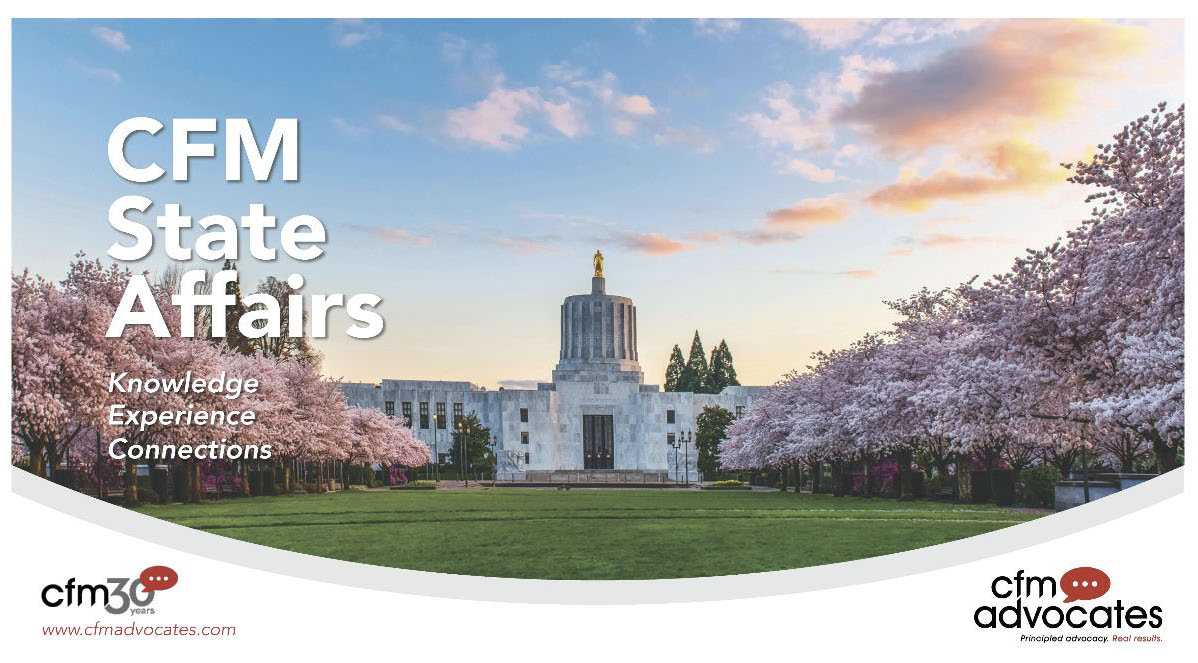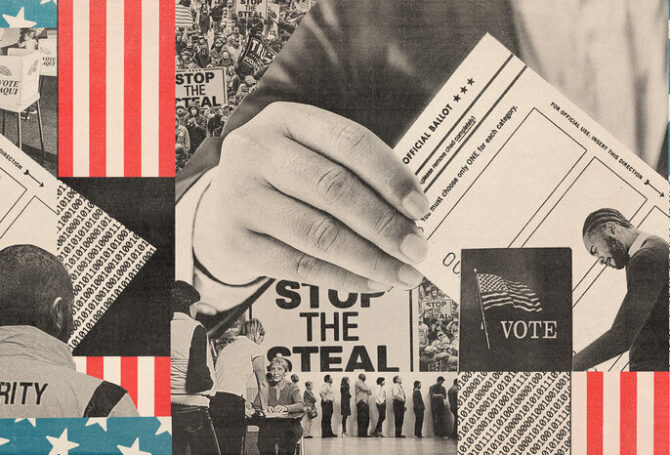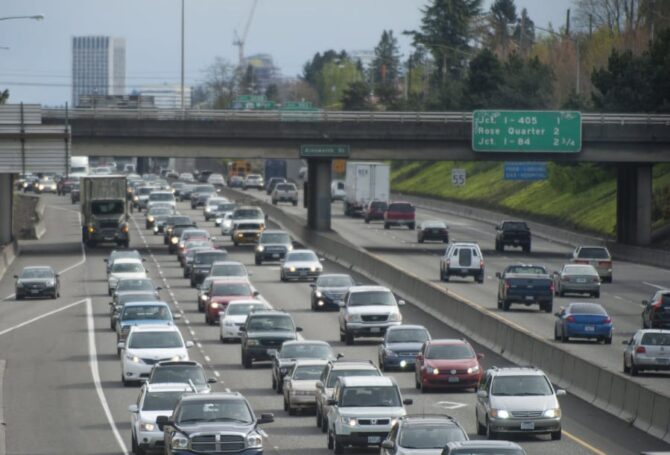
Decision Puts Pressure on 2025 Legislature to Boost Transportation Funding
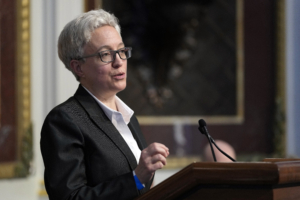
The bell tolled last week for tolling on major Portland freeways as Governor Kotek ordered the Department of Transportation to scrap existing plans and go back to the drawing board. ODOT has spent $61 million on developing the tolling plan to this point.
The now scrapped plan called for tolling on I-5 and I-205 to curb rush-hour congestion and on the I-205 Abernethy Bridge to pay for seismic upgrades. Kotek said tolling wasn’t worth the cost of collecting tolls and diverting traffic to already congested secondary roads.
Her action did not apply to tolling on the I-5 Columbia River Bridge replacement, though her decision may shift toll collection to Washington, which already has tolling infrastructure in place.
Kotek’s decision underscores the importance of interim work to develop a 2025 legislative session transportation funding proposal. Lawmakers already face the challenge of truckers overpaying their share of road taxes and ODOT’s inadequate road maintenance budget caused by lower gas tax revenues from more efficient cars and more electric vehicles.
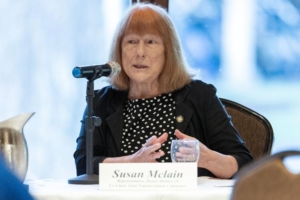 Rep. Susan McLain, D-Forest Grove, co-chair of the Legislature’s Joint Transportation Committee, said Kotek’s letter “did not disrupt what we’re doing at the legislature or what we planned to get completed. Oregon needs stable and sufficient transportation dollars that the public can support.” While she agreed with Kotek’s decision, McLain said it will be much harder to restore a tolling plan.
Rep. Susan McLain, D-Forest Grove, co-chair of the Legislature’s Joint Transportation Committee, said Kotek’s letter “did not disrupt what we’re doing at the legislature or what we planned to get completed. Oregon needs stable and sufficient transportation dollars that the public can support.” While she agreed with Kotek’s decision, McLain said it will be much harder to restore a tolling plan.
“While I believe tolling cannot be the only tool to solve all our challenges, as steward of our state’s transportation system, I believe it should be one of our tools,” said Julie Brown, chair of the Oregon Transportation Commission.
Opposition to Highway Tolling
Critics say Washington spends 37 percent of toll revenue on its two Vancouver-area highways to collect tolls, which doesn’t include additional costs to maintain the tolling system. Washington doesn’t provide lower rates for low-income drivers, which the Oregon tolling plan would have done and substantially reduced tolling revenue. ODOT also would have to stand up a new division of employees to run the tolling system.
 Local governments and others have complained the Portland-area tolls would lead drivers to switch to arterials. A Metro analysis predicted as many as 25 percent of freeway users would divert to and congest non-freeway roads.
Local governments and others have complained the Portland-area tolls would lead drivers to switch to arterials. A Metro analysis predicted as many as 25 percent of freeway users would divert to and congest non-freeway roads.
Toll revenues were anticipated to support construction bonding. However, uncertainty over how much revenue tolls would generate could make bonding more expensive to obtain. Washington relied on tolling to cover bonds for a major tunnel in Seattle. When toll revenues fell short of projections, Washington lawmakers were forced make up the difference.
Kotek and Tolling History
Kotek was House Speaker in 2017 that passed legislation kickstarting tolling plans for Portland highways. She reiterated her support for tolling three years later while still Speaker as she called for “more immediate implementation of regionwide congestion pricing and tolling.”
After becoming governor, Kotek softened her support for regionwide tolling and called for delaying any tolls until at least 2026.
Opposition to tolling has been most intense in Clackamas County. A survey found 91 percent of county residents oppose tolling, perhaps influenced by a recent ODOT presentation to the legislature indicating surge pricing on Portland freeways could be as high as $5.60 during rush hour.
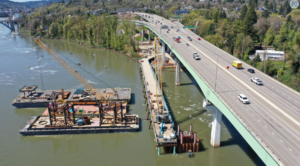 Jettisoning tolling raises questions about financing seismic upgrades to Abernethy Bridge on I-205 between Oregon City and West Linn.
Jettisoning tolling raises questions about financing seismic upgrades to Abernethy Bridge on I-205 between Oregon City and West Linn.
Legislative Democrats representing parts of Clackamas County celebrated Kotek’s announcement to set aside highway tolls. “We worked hard to ensure that the voices of those in our communities were heard in public meetings, testimony and advocacy,” said a statement by Reps. Annessa Hartman, D-Gladstone, Jules Walters, D-West Linn, and Courtney Neron, D-Wilsonville. “This tolling reversal means a lot to those who live and work here.”
“This tolling reversal means a lot to those
who live and work in Clackamas County.”
Toll Road History
Toll roads started in America in the 18th century when a push westward required turning trails into roads made of crushed rock. The first private turnpike was chartered in 1792 in Pennsylvania. It spawned 67 turnpike companies in New York and 50 in Connecticut. The longest turnpike connected to Boston and extended 32 miles. It cost $12,500 per mile to build.
Congress in 1806 approved legislation to fund what became known as Cumberland Road, though roads remained crude and often impassable during bad weather until the 1880s and the advent of the Goad Roads Movement spurred by bicycle riders. As more cars hit the road, policymakers realized the roads had to be better.
World War I cemented the nation’s dependence on improved roads to move cargo and support the mobility of Americans. By the end of the 1920s, half of American families owned a car. Improved roads required better bridges and tunnels to handle growing traffic. The Holland Tunnel in New York was completed in the mid-1920s. The Golden Gate Bridge in San Francisco was built in the 1930s.
World War II created an even greater reliance on surface transportation, prompting President Eisenhower after the war to call for an interstate highway system. Lawmakers considered making super-highways toll roads, but decided instead to use federal funding. Tolls re-emerged as a financing option as roads began reaching their useful life.
Interest in tolling grew when electronic tolling became realistic. Toll roads exist in 35 states, with relatively few exceptions in the West and South.
Tolls were used to pay for the original and second bridge over the Columbia River on what is now I-5. After bonds were retired, the tolls were dropped.
 Tolling also paid for the 4.1-mile Astoria-Megler Bridge, which completed the multi-state Highway 101 when it opened in 1996. Tolling ended on the longest continuous truss bridge in North America in 1993, two years earlier than projected.
Tolling also paid for the 4.1-mile Astoria-Megler Bridge, which completed the multi-state Highway 101 when it opened in 1996. Tolling ended on the longest continuous truss bridge in North America in 1993, two years earlier than projected.
The Bridge of the Gods is a toll bridge connecting Washington’s SR-14 and I-84 in Oregon. It is owned and operated by the Port of Cascade Locks. Farther east is the Hood River-White Salmon Interstate bridge, which also connects SR-14 and I-84 and is operated by the Port of Hood River.
